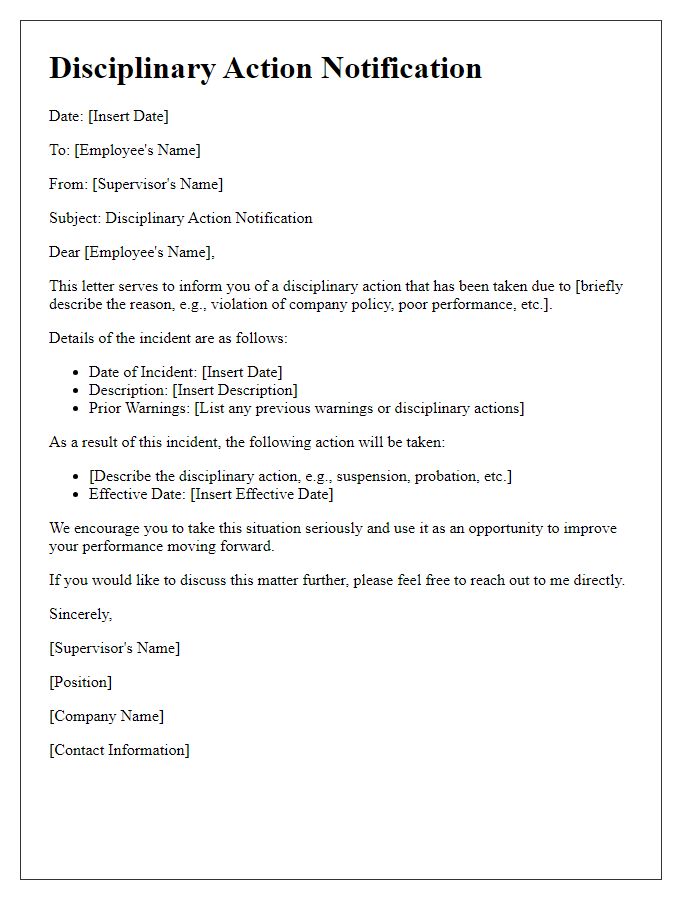Are you facing the task of writing a letter for a disciplinary action? It can be a challenging endeavor, but with the right approach, you can craft a message that is clear and constructive. Whether it's to address performance issues, misconduct, or policy violations, being concise and respectful is key to maintaining a professional tone. Ready to learn how to effectively communicate this sensitive topic? Let's dive in!

Clarity in Explanation
Disciplinary actions in workplaces involve various procedures and policies, defined by organizations to maintain workplace integrity and productivity. Clear communication is essential, particularly in documenting the reasoning behind disciplinary measures. A thorough explanation should include the specific behavior that violated workplace policies (for instance, tardiness policy breaches exceeding three occurrences in a month). Include any prior warnings issued, along with dates and details of those discussions. Outline the expected standards (for example, punctuality expectations of arriving within five minutes of scheduled start time) and the implications of repeated violations. Highlight the potential consequences of further infractions, which could range from additional sanctions to termination per HR policy guidelines. This approach ensures clarity in the process, fostering transparency and understanding among all parties involved.
Objective Language
Disciplinary action is an essential process within organizational management, aiming to address employee misconduct or performance issues. A well-structured disciplinary action explanation often begins with outlining specific incidents, such as tardiness (often defined as arriving 15 minutes late or more) or policy violations (like workplace harassment). Documentation (such as written warnings dated within a specified timeframe) is crucial for transparency. The explanation should include reference to relevant company policies (outlined in the employee handbook) and previous discussions or warnings (including dates and participants involved) surrounding the matter. Furthermore, it is vital to clarify the potential consequences (ranging from suspension to termination) and the steps the employee can take to rectify the situation, thereby promoting accountability and a path toward improvement.
Specific Incident Details
A disciplinary action report details the specific incident involving an employee's behavior that violated company policies. On October 5, 2023, at 2:00 PM, in the main conference room of Acme Corporation located in Dallas, Texas, employee John Smith was observed engaging in loud arguments with colleagues, disrupting a scheduled team meeting. The incident lasted approximately 15 minutes, during which John's refusal to listen to feedback and use of inappropriate language created an uncomfortable environment for other team members. Witnesses reported feelings of distress and unease due to the confrontation, which directly contradicted the organization's commitment to maintaining a respectful workplace. In accordance with company guidelines, a formal review of this incident will be conducted to determine appropriate disciplinary measures.
Policy References
Disciplinary actions often stem from violations of company policies, which outline expected behaviors and responsibilities of employees. Policies relevant to disciplinary actions include the Employee Conduct Policy, which delineates appropriate workplace behavior and outlines the consequences for infractions. The Attendance Policy specifies expectations regarding punctuality and absences, stating that excessive tardiness may lead to disciplinary measures. The Code of Ethics serves as a framework for maintaining integrity and professionalism, with specific guidelines on conflicts of interest and unacceptable conduct. Additionally, the Harassment Policy protects employees from discrimination and unethical behaviors, emphasizing the company's commitment to a safe work environment. Understanding these policies helps clarify the rationale behind disciplinary actions taken against employees.
Improvement Suggestions
Disciplinary actions within organizations often arise from various factors, such as consistent performance issues, violations of company policies, or inappropriate behavior. To facilitate improvement, employees are encouraged to focus on key areas such as punctuality, adherence to workplace conduct, and skill enhancements relevant to their role. Specific training programs or mentorship opportunities can be beneficial in addressing skill gaps, while establishing clear communication channels with supervisors can help clarify expectations. Additionally, setting measurable goals to track progress, such as attendance records or performance metrics, can assist in maintaining accountability. Regular feedback sessions can provide insights into areas needing further development, fostering a supportive environment for growth and improvement.













Comments